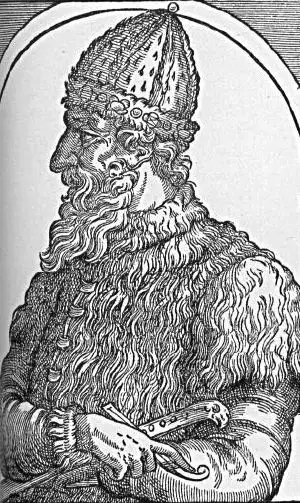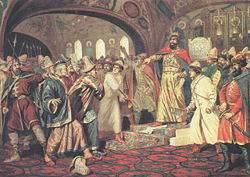Difference between revisions of "Ivan III of Russia" - New World Encyclopedia
| Line 49: | Line 49: | ||
==Further reading== | ==Further reading== | ||
| − | * | + | * [[Sigismund von Herberstei]]. ''[[450 Jahre Sigismund von Herbersteins Rerum Moscoviticarum Commentarii : 1549-1999]]''. Wiesbaden : Harrassowitz, 2002 ISBN 3447046252 Jubiläumsvorträge herausgegeben von Frank Kämpfer und Reinhard Frötschner. This book contains much information on Ivan III and his court. |
==External links == | ==External links == | ||
Revision as of 02:33, 6 September 2006
Ivan III Vasilevich (Иван III Васильевич) (January 22, 1440 – October 27, 1505), also known as Ivan the Great, was a grand duke of Muscovy who first adopted a more pretentious title of the "grand duke of all the Russias". Sometimes referred to as the "gatherer of the Russian lands", he quadrupled the territory of his state, claimed Moscow to be a Third Rome, built the Moscow Kremlin, and laid foundations for the Russian autocracy. He was the longest-reigning Russian ruler ever.
Background
Ivan's parents were Vasily II and Maria of Borovsk. When Ivan was five, his father was blinded during unsuccessful coup de tat. At the age of seven he was married with the doughter of the duke of Tver (his future first wife) as exchange for help and protection. At the age of eight (1448) he joined compain against khanate of Kazan to deffend Vladimir and Murom principalities. He became co-regent with his father in 1450 and succeeded him in 1462. Ivan persistently pursued the unifying policy of his predecessors. Nevertheless, he was cautious, like many of the princes of the house of Rurik. Some sources assighn this to timidity, others to cold heartedness and wisdom. Cite error: Invalid <ref> tag; refs with no name must have contentEither way, he avoided as far as possible any violent collision with his neighbors until all the circumstances were exceptionally favorable, always preferring to attain his ends gradually and indirectly, "slowly but surely". Muscovy had by this time become a compact and powerful state, while her rivals had grown sensibly weaker, a condition of things very favorable to the speculative activity of a statesman of Ivan III's peculiar character.
Gathering of Russian lands
His first enterprise was a war with the republic of Novgorod, which, alarmed at the growing influence of Muscovy, had placed itself beneath the protection of Casimir IV, king of Poland. This alliance regarded at Moscow as an act of apostasy from orthodoxy. Although he would have used any old excuse before nationalism was invented, religion was always the best bet, Ivan marched against Novgorod in 1470. No allies stood up for Novgorod. After his generals had twice defeated the forces of the republic (by legend, ten fold outnumbered), at the rivers Shelona and Dvina, during the summer of 1471, the Novgorodians were forced to sue for peace, which they obtained by agreeing to abandon for ever the Polish alliance, ceding a considerable portion of their northern colonies, and paying a war indemnity of 15,500 roubles.
From then on Ivan sought continually a excuse for destroying Novgorod altogether. Though he frequently violated its ancient privileges in minor matters, the attitude of the republic was so careful that his looked-for opportunity did not come till 1477. In that year the ambassadors of Novgorod played into his hands by addressing him in public audience as Gosudar (sovereign) instead of Gospodin (sir) as heretofore. Ivan at once seized upon this as a recognition of his sovereignty, and when the Novgorodians repudiated their ambassadors, he marched against them. Deserted by Casimir IV, and surrounded on every side by the Muscovite armies, which included a Tatar contingent, the republic recognized Ivan as autocrat, and surrendered (January 14, 1478) all her prerogatives and possessions (the latter including the whole of northern Russia from Lapland to the Urals) into his hands.
Subsequent revolts (1479-1488) were punished by the removal en masse of the richest and most ancient families of Novgorod to Moscow, Vyatka and other central Russian cities. After this, Novgorod, as an independent state, ceased to exist. The rival republic of Pskov owed the continuation of its own political existence to the readiness with which it assisted Ivan against its ancient enemy. The other principalities were virtually absorbed, by conquest, purchase or marriage contract: Yaroslavl in 1463, Rostov in 1474, and Tver in 1485.
Ivan's refusal to share his conquests with his brothers, and his subsequent interference with the internal politics of their inherited principalities, involved him in several wars with them. Though the princes were assisted by Lithuania, Ivan emerged victorious. Finally, Ivan's new rule of government, formally set forth in his last will to the effect that the domains of all his kinsfolk, after their deaths, should pass directly to the reigning grand duke instead of reverting, as thus far, to the princes heirs, put an end once and for all to these semi-independent princelets.
Foreign policies
It was in the reign of Ivan III that Muscovy rejected the Tatar yoke. In 1480 Ivan refused to pay the customary tribute to the grand Khan Ahmed. When, however, the grand khan marched against him, Ivan's courage began to fail, and only the stern exhortations of the high-spirited bishop of Rostov, Vassian, could induce him to take the field. All through the autumn the Russian and Tatar hosts confronted each other on opposite sides of the Ugra river, till the 11th of November, when Ahmed retired into the steppe.
In the following year the grand khan, while preparing a second expedition against Moscow, was suddenly attacked, routed and slain by Ivaq, the khan of the Nogay Horde, whereupon the Golden Horde suddenly fell to pieces. In 1487 Ivan reduced the khanate of Kazan (one of the offshoots of the Horde) to the condition of a vassal-state, though in his later years it broke away from his suzerainty. With the other Muslim powers, the khan of the Crimean Khanate and the sultans of Ottoman Empire, Ivan's relations were pacific and even friendly. The Crimean khan, Meñli I Giray, helped him against Grand Duchy of Lithuania and facilitated the opening of diplomatic intercourse between Moscow and Istanbul, where the first Russian embassy appeared in 1495.
In Nordic affairs, Ivan III concluded an offensive alliance with Hans of Denmark and maintained a regular correspondence with Emperor Maximilian I, who called him a "brother". He built a strong citadel in Ingria (named Ivangorod after himself), which proved of great consequence to Russians in the war with Sweden, which had been preceded by Ivan's detention of the Hanseatic merchants trading in Novgorod.
The further extension of the Muscovite dominion was facilitated by the death of Casimir IV in 1492, when Poland and Lithuania once more parted company. The throne of Lithuania was now occupied by Casimir's son Alexander, a weak and lethargic prince so incapable of defending his possessions against the persistent attacks of the Muscovites that he attempted to save them by a matrimonial compact, and wedded Helena, Ivan's daughter. But the clear determination of Ivan to appropriate as much of Lithuania as possible at last compelled Alexander in 1499 to take up arms against his father-in-law. The Lithuanians were routed at Vedrosha (July 14, 1500), and in 1503 Alexander was glad to purchase peace by ceding to Ivan Chernigov, Starodub, Novgorod-Seversky and sixteen other towns.
Internal policies
The character of the government of Muscovy under Ivan III changed essentially and took on an autocratic form which it had never had before. This was due not merely to the natural consequence of the hegemony of Moscow over the other Russian lands, but even more to the simultaneous growth of new and exotic principles falling upon a soil already prepared for them. After the fall of Constantinople, orthodox canonists were inclined to regard the Muscovite grand dukes as the successors of the Byzantine emperors.
This movement coincided with a change in the family circumstances of Ivan III. After the death of his first consort, Maria of Tver (1467), at the suggestion of Pope Paul II (1469), who hoped thereby to bind Russia to the holy see, Ivan III wedded Sophia Paleologue (also known under her original Greek and Orthodox name of Zoe), daughter of Thomas Palaeologus , despot of Morea, who claimed the throne of Constantinople as the brother of Constantine XI, last Byzantine emperor.
The main condition of thier union was that their children would not inherit Moscow thron. Cite error: Invalid <ref> tag; refs with no name must have content However, frustrating the Pope's hopes of re-uniting the two faiths, the princess reverted to Orthodoxy. Due to her family traditions, she awoke imperial ideas in the mind of her consort. It was through her influence that the ceremonious etiquette of Constantinople (along with the imperial double-headed eagle and all that it implied) was adopted by the court of Moscow.
The grand duke from this time forth held aloof from his boyars. He would never lead military compain himself anymore, relying on his generals. The old patriarchal systems of government vanished. The boyars were no longer consulted on affairs of state. The sovereign became sacrosanct, while the boyars were reduced to the level of slaves absolutely dependent on the will of the sovereign. The boyars naturally resented such insulting revolution, and struggled against it, at first with some success. At some point they could set up Sophia and allienate her from him. But the clever Greek lady prevailed in the end, and it was her son Vasily, not Maria of Tver's son, Ivan, who was ultimately crowned co-regent with his father (April 14, 1502).
It was in the reign of Ivan III that the new Russian Sudebnik, or law code, was compiled by the scribe Vladimir Gusev. Ivan did his utmost to make his capital a worthy successor to Constantinople, and with that vision invited many foreign masters and craftsmen to settle in Moscow.
The most noted of these was the Italian Ridolfo di Fioravante, nicknamed Aristotle because of his extraordinary knowledge, who built several cathedrals and palaces in the Kremlin. This extraordinary monument of the Muscovite art remains a lasting symbol of the power and glory of Ivan III.
Notes
XPOHOC.[1] Russian history in the mirror of fine art.[2]
ReferencesISBN links support NWE through referral fees
- This article incorporates text from the Encyclopædia Britannica Eleventh Edition, a publication now in the public domain.
Further reading
- Sigismund von Herberstei. 450 Jahre Sigismund von Herbersteins Rerum Moscoviticarum Commentarii : 1549-1999. Wiesbaden : Harrassowitz, 2002 ISBN 3447046252 Jubiläumsvorträge herausgegeben von Frank Kämpfer und Reinhard Frötschner. This book contains much information on Ivan III and his court.
External links
| Preceded by: Vasili II |
Grand Prince of Moscow 1462–1505 |
Succeeded by: Vasili III |
Credits
New World Encyclopedia writers and editors rewrote and completed the Wikipedia article in accordance with New World Encyclopedia standards. This article abides by terms of the Creative Commons CC-by-sa 3.0 License (CC-by-sa), which may be used and disseminated with proper attribution. Credit is due under the terms of this license that can reference both the New World Encyclopedia contributors and the selfless volunteer contributors of the Wikimedia Foundation. To cite this article click here for a list of acceptable citing formats.The history of earlier contributions by wikipedians is accessible to researchers here:
The history of this article since it was imported to New World Encyclopedia:
Note: Some restrictions may apply to use of individual images which are separately licensed.



